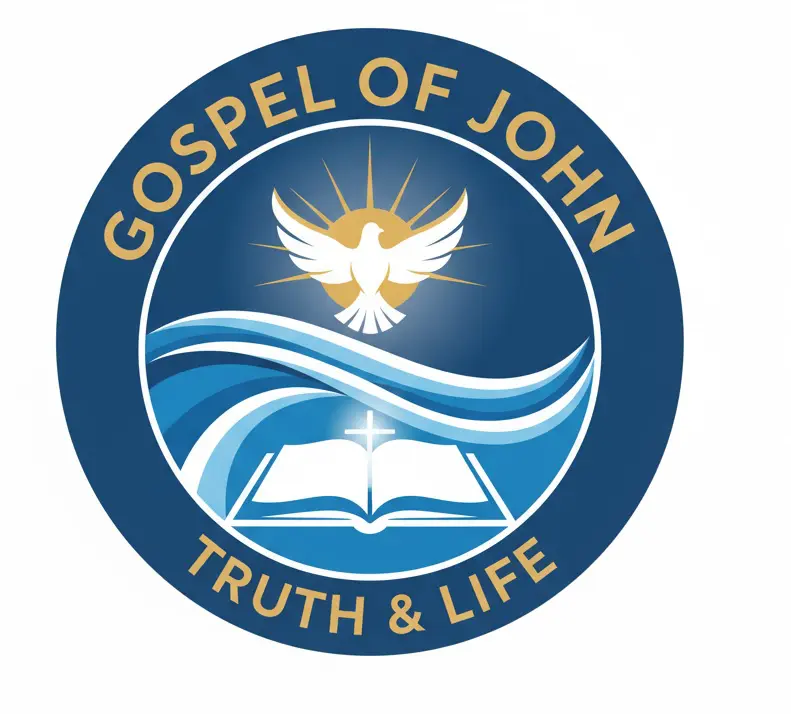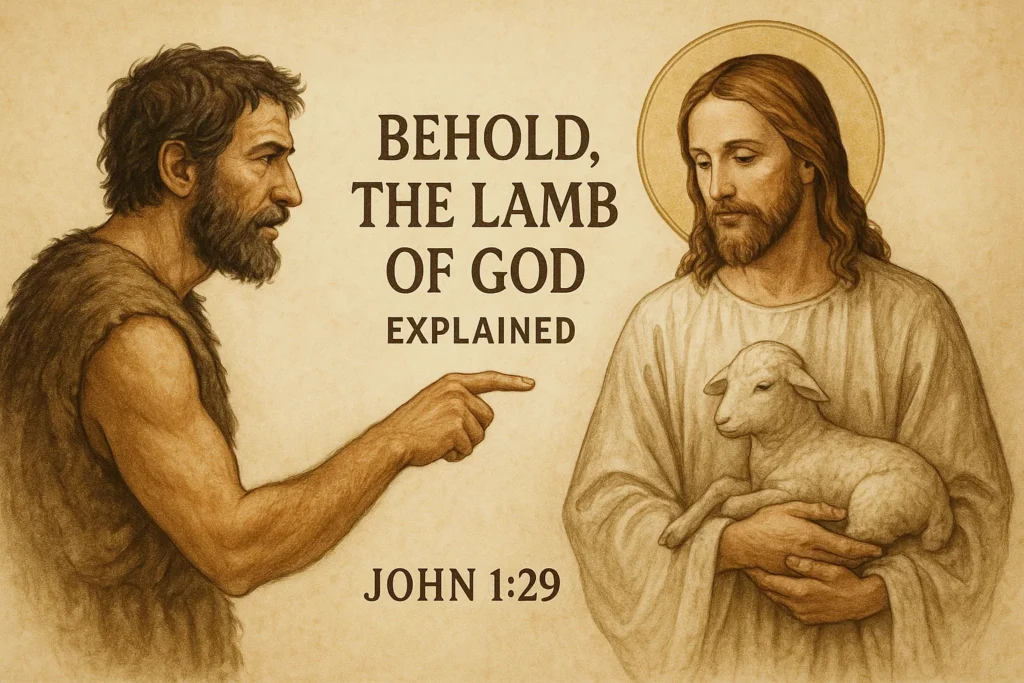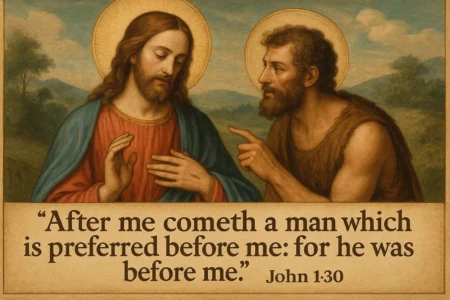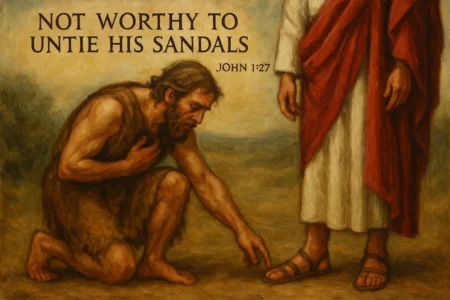History-changing introductions don’t get much bigger. A rugged prophet, looking like he just walked out of the wilderness (because he did), points to a relative passing by. Then he makes a declaration that literally alters the course of the world.
“Behold, the Lamb of God, who takes away the sin of the world!” (John 1:29).
That phrase is everywhere. We’ve sung it. We’ve read it. We’ve seen it stitched on banners. But have we ever really just stopped and let the full weight of it hit us? The John 1:29 meaning isn’t just a fancy title. It’s a riddle. It’s a prophecy. It’s a complete theological bombshell crammed into three little words: “Lamb of God.”
Think about who heard this first. For a first-century Jewish audience, this was an explosive, almost nonsensical thing to say.
A lamb?
Not a lion. Not a king. Not a conquering general. A lamb was for sacrifice. It was the animal of Passover. The creature of atonement. The symbol of blood spilled to cover sin. It meant meekness. Vulnerability. And this man, John the Baptist, points to Jesus of Nazareth and says, “There he is. He is the ultimate sacrifice. For all people. For all time.”
Honestly, to understand this one verse is to get the entire Christian gospel. So, let’s dig in. Let’s unpack the profound identity John was revealing.
More in John Chapter 1 Category
Key Takeaways
- A Shocking Title: Calling the long-awaited Messiah a “Lamb” was radically counter-cultural. The Jewish people were expecting a powerful, political hero, not a sacrificial victim.
- The Passover Connection: “Lamb of God” is a direct pointer to the Passover lamb in Exodus. Its blood saved the Israelites from death in Egypt; John presents Jesus as the one whose sacrifice saves all people from spiritual death.
- Temple Sacrifice: The title also pulls from the millions of lambs sacrificed daily and yearly at the Jerusalem Temple for sin. John identifies Jesus as the final, perfect, and all-sufficient sacrifice that makes the old system obsolete.
- The Prophecy of Isaiah: John was almost certainly referencing the “Suffering Servant” in Isaiah 53, who is “led like a lamb to the slaughter” and “bore the sin of many.”
- A Global Mission: The phrase “sin of the world” was a huge shift. It declared this Lamb’s saving work wasn’t just for Israel, but for all humanity. This was a universal atonement.
What’s the Scene? Who Was John the Baptist Anyway?
To really get the John 1:29 meaning, you have to paint the picture. This isn’t some quiet, sterile seminary classroom. This is the wilderness. The air is electric. You can feel the anticipation. Huge crowds are trekking from Jerusalem out to the Jordan River, pulled by this magnetic, camel-hair-wearing prophet.
John the Baptist.
I’ve always been fascinated by this guy. He’s the total opposite of a polished, put-together speaker. The man eats bugs and wild honey. He pulls zero punches. He flat-out calls the religious elite a “brood of vipers.” He is raw. He is completely authentic. And his message burns with urgency: “Repent, for the kingdom of heaven is at hand!”
People were flocking to him. Confessing their sins. Getting baptized as this public symbol of a fresh start. There was a buzz. You could feel it. Everyone was asking the one question: “Is this the one? Is this the Messiah?”
Why Were People So Desperate for a Messiah?
You just can’t grasp the hope for a Messiah without first grasping the pain of the occupation. Israel was living under the brutal, heavy boot of the Roman Empire.
These were a proud people. A people with a history defined by God’s deliverance. Yet, here they were, paying taxes to a pagan emperor who had the nerve to call himself a god. They were chafing under Roman law. Roman soldiers. Roman cruelty.
Their own scriptures, what we call the Old Testament, were bursting with promises of a Deliverer. They were desperate for a new King David, a military and political genius. They dreamed of someone who would rally the nation, shatter the Roman legions, and put Israel back on top. They wanted a lion. They were praying for a king.
So, When John Said “Lamb,” What Did People Hear?
Imagine the emotional whiplash. You have religious leaders, soldiers, hated tax collectors, and everyday farmers all standing there. Their hearts are pounding with hope for a conqueror. Then John, the prophet they all trust, points to a carpenter from the middle-of-nowhere town of Nazareth. And he says, “Behold, the Lamb.”
A lamb?
It must have felt like a stunning anti-climax. A punch to the gut. A lamb doesn’t fight. A lamb doesn’t conquer. A lamb bleats. A lamb gets led. A lamb… dies.
This single word demolished all their political and military dreams. John wasn’t pointing to a new King David. He was pointing to a new kind of sacrifice. This statement would have been confusing. Bizarre. And for many, a bitter disappointment. John was completely reframing their entire hope. He was essentially telling them, “You’re looking for someone to save you from Rome, but God sent someone to save you from your sins. You’re looking for a crown, but you should be looking for a cross.”
Why a “Lamb” of All Things? What’s the Old Testament Connection?
John the Baptist didn’t just pull this metaphor out of thin air. He was a man who lived and breathed the Hebrew Scriptures. When he said “Lamb of God,” his Jewish audience would have had a flash-flood of images and stories rush into their minds. This wasn’t some fuzzy metaphor for gentleness. It was a precise, bloody, and heavyweight theological term.
Is This a Direct Link to the Passover Lamb?
Yes. Absolutely. This is the most powerful and immediate connection. You simply could not be a Jewish person in the first century and hear the word “lamb” without immediately thinking of Passover.
This reminds me of my old Sunday School class. The teacher, trying to explain Passover, had us paint red “blood” (it was just red paint) on little paper doorposts. It was a craft project for us. But for them, it was history. It was their founding story.
Every family. Every single year. They sacrificed a lamb. They would re-tell the story from Exodus 12. They’d talk about how their ancestors were slaves in Egypt. They’d recount how God promised to “pass over” any house that had the blood of a spotless lamb on its doorposts, saving the firstborn son inside from death. That lamb’s blood was the literal price of their freedom. It was a substitute. The lamb died so the son could live.
When John points to Jesus and says, “Behold, the Lamb,” he’s making a claim of cosmic proportions. He’s saying:
- Just as that lamb’s blood saved our ancestors from physical death, this man’s sacrifice will save all of us from spiritual death.
- He is the fulfillment of that ancient, powerful symbol.
- He is the ultimate Passover Lamb, not just for one nation, but for the entire world.
What About the Daily Sacrifices at the Temple?
The Passover was a huge, once-a-year event. But the sacrifices? They never stopped.
Every single morning and every single evening, a lamb was sacrificed in the Jerusalem Temple. This was the Tamid offering—the continual sacrifice. It was done for the sins of the nation.
Think about the sheer number. Historians estimate that, when you include personal offerings and festival days, hundreds of thousands of lambs were sacrificed. The temple was, in many ways, an industrial-scale slaughterhouse. The whole system was built on one stark idea: sin is deadly serious, and it requires the shedding of blood for atonement.
When John says, “Behold, the Lamb of God,” he is also saying, “The ultimate, final sacrifice has arrived.” He is signaling the beginning of the end for that entire system. This one Lamb, he claims, would accomplish what those millions of lambs could only point toward. He is the one-time, perfect, and final offering for sin.
Did John Have a Specific Prophecy in Mind?
This is where it gets even more specific. Many scholars are convinced John wasn’t just thinking of the sacrificial system in general. He was thinking of one specific, haunting prophecy.
Could John Be Pointing to Isaiah’s “Suffering Servant”?
This seems incredibly likely. The prophet Isaiah, writing hundreds of years earlier, penned four “Servant Songs” about a mysterious figure who would come to save Israel. The most famous, by far, is Isaiah 53.
And what does it say?
“He was oppressed and afflicted, yet he did not open his mouth; he was led like a lamb to the slaughter, and as a sheep before its shearers is silent, so he did not open his mouth.” (Isaiah 53:7)
This prophecy describes a figure who doesn’t conquer with a sword. He saves by suffering. This Servant would be “pierced for our transgressions” and “crushed for our iniquities.” And “by his wounds we are healed.” The Lord, Isaiah writes, will “lay on him the iniquity of us all.”
This passage is just a stunningly accurate preview of the passion, crucifixion, and substitutionary death of Jesus. For more on the deep textual history of this passage, academic resources like those from seminaries such as the Dallas Theological Seminary provide extensive analysis.
John the Baptist, a man soaked in prophecy, sees Jesus. He connects the dots. He knows the sacrificial system. He knows the Passover story. And he knows the Suffering Servant prophecy. He bundles all of it together in one explosive title: “The Lamb of God.”
What About the “Aqedah”? The Binding of Isaac?
Here’s one more layer. Every Jewish person in that crowd knew the story of Abraham and Isaac from Genesis 22. Abraham is commanded by God to sacrifice his own son, Isaac. At the very last second, God intervenes. He provides a ram (a male sheep) caught in a thicket to be sacrificed instead of Isaac.
On that mountain, God himself provided a substitute.
This story, known in Hebrew as the Aqedah (the Binding), was a powerful, foundational picture of substitutionary sacrifice. It’s very, very possible this story was also in John’s mind. He is declaring that God has once again provided a substitute. But this time, it’s not a ram instead of one boy. This time, it’s God’s own Son, as the Lamb, instead of the world.
What Does “Who Takes Away the Sin of the World” Really Mean?
This second half of the verse is just as radical as the first. John doesn’t just give Jesus a title. He gives him a job description.
How Does a Lamb “Take Away” Sin?
The Greek word here for “takes away” is airōn. It’s a great word. It can mean “to lift up and carry away,” or it can mean “to remove completely.” Both meanings are beautiful.
Think of the scapegoat on the Day of Atonement (Yom Kippur). The High Priest would symbolically lay all the sins of all the people onto the head of a goat. That goat was then driven out into the wilderness, to “carry away” their sins. That’s one image. Jesus is the one who carries our sins far away from us.
The other image is that of cleansing. His sacrifice doesn’t just cover sin, like sweeping dirt under a rug. It removes it. It cleans the slate. It washes the stain.
I’ve told this story before, but it’s the best picture I’ve got. For years, I imagined my sin was this massive, heavy backpack. My backpack. I was just weighed down by my mistakes, my anger, the things I’d said and done. The idea of Jesus as the Lamb meant he didn’t just pat me on the back and help me carry the bag.
He took the bag from me. He lifted it. And he carried it away.
That’s the power of airōn.
Why “the World”? Wasn’t the Messiah for Israel?
This. This right here might be the most shocking part of the whole statement for his original audience.
Everything in their world was about Israel. The promises were for Israel. The covenant was with Israel. The Messiah was Israel’s king. The sacrifices in the temple? They were for the sins of the Jewish people.
And in one phrase, “the sin of the world,” John shatters that exclusivity. He declares that God’s plan is global. This Lamb’s sacrifice isn’t just for one ethnic group or one nation. It’s for everyone.
It’s for the Roman soldier who was oppressing them. It’s for the Greek philosopher who mocked them. It’s for the pagan tribes on the farthest edges of the map.
It’s for you. And it’s for me. This was a radical, barrier-breaking, universal message.
How Did This Statement Change Everything?
John’s declaration wasn’t just a nice theological point for a sermon. It was a recruiting speech. It was a hand-off.
What Happened Immediately After John Said This?
The very next day (John 1:35-37), John the Baptist is standing there with two of his own disciples. He sees Jesus walking by again and says it one more time. “Behold, the Lamb of God!”
And what happened? The Bible says, “The two disciples heard him speak, and they followed Jesus.”
They just left. That’s the entire point. John’s job was to point. He was the signpost, not the destination. His declaration was so powerful, so compelling, that his own followers immediately left him to follow the one he was pointing to. One of those two disciples was Andrew. And the first thing Andrew did? He sprinted to his brother, Simon Peter, and said, “We have found the Messiah!” (John 1:41).
And so it began. That one sentence, “Behold, the Lamb of God,” was the spark that lit the fire of the entire Christian movement. It was the official passing of the torch.
Has This Image of the Lamb Endured?
It’s not just in the Gospel of John. This image of Jesus as the Lamb is the thread that runs all the way to the very end of the Bible.
When you get to the last book, Revelation, what is the central image of heaven? It’s not a throne room with a powerful king sitting on it. It’s a throne room with a Lamb.
- Revelation 5:6: “And I saw a Lamb, looking as if it had been slain, standing in the center of the throne…”
- Revelation 7:17: “For the Lamb at the center of the throne will be their shepherd…”
- Revelation 22:1: “Then the angel showed me the river of the water of life… proceeding from the throne of God and of the Lamb.”
The entire vision of eternity, the grand finale of the whole story, is centered on this beautiful, powerful paradox. The one who is worthy to rule is the one who was willing to be slain. His power comes from his sacrifice. His authority comes from his humility. The Lamb is the Lion.
What Does “John 1:29 Meaning” Imply for Us Today?
This isn’t just some ancient history lesson. The meaning of this verse has profound, practical implications for how we live. Right here. Right now.
Does This Redefine Our Idea of Strength?
I think it has to. As a man, I was raised with the idea that strength is about being loud. Being in control. Being invulnerable. Strength is the lion, not the lamb. But the Lamb of God just flips that whole script upside down.
This hits home for me. I had this situation at work once. A colleague made a huge mistake. A really bad one. It put our whole team in jeopardy. He was terrified. My first instinct? Pure anger. I wanted to call him out. I wanted to assign blame and make sure everyone knew I wasn’t the one who messed up.
But I felt this check in my spirit. I remembered this image of the Lamb—the one who absorbs the blow instead of deflecting it.
I ended up taking a portion of the blame with him, even though it wasn’t my fault. I worked with him through the weekend to fix it. It was an act of “lamb-like” sacrifice, and I’ll be honest, it was terrifying. But it saved his job. And in a strange way, it forged a bond of trust that was far more powerful and real than any angry outburst could have ever been.
This is the paradox. True strength isn’t in our ability to dominate. It’s in our willingness to sacrifice. It’s the quiet, solid power of grace, forgiveness, and bearing one another’s burdens.
So, What’s Our Response to the Lamb?
John’s disciples gave us the blueprint. When they heard the truth about who Jesus was, they followed him. The John 1:29 meaning isn’t just something to be studied. It’s someone to be followed.
It means we can stop trying to earn our way to God. It means we stop trying to “fix” our sin problem with our own good works, our own striving. The old sacrificial system was exhausting. It was a constant, bloody reminder that the debt could never, ever truly be paid.
The Lamb of God steps into history and says, “It is finished.”
To “behold” the Lamb means to fix our eyes on him. It means to trust his finished work. It means to finally accept that his sacrifice was enough, once and for all. It means laying down our pride, our self-sufficiency, and all our own efforts… and simply following the one who “takes away the sin of the world.”
FAQ
What is the significance of the title ‘Lamb of God’ used by John the Baptist?
The title ‘Lamb of God’ signifies Jesus’ role as the ultimate sacrifice for sin, connecting to Old Testament imagery of Passover and temple sacrifices, and highlighting his purpose to save the world from spiritual death.
Why was the title ‘Lamb’ shocking to the Jewish audience of the first century?
It was shocking because they expected a powerful king or conqueror, but ‘Lamb’ represented meekness, vulnerability, and sacrifice, which contrasted sharply with their hopes for a political/military messiah.
How does the Passover lamb relate to Jesus as the ‘Lamb of God’?
The Passover lamb, whose blood saved the Israelites from death in Egypt, directly parallels Jesus’ sacrifice that offers salvation from spiritual death; he is seen as the ultimate Passover Lamb providing eternal atonement.
What does the phrase ‘takes away the sin of the world’ imply in this context?
It implies that Jesus’ sacrifice is sufficient to remove or carry away the sins of all humanity, offering universal redemption and cleansing from sin, profound praise for his role in salvation.
How does the image of the Lamb challenge conventional ideas of strength?
It redefines strength as sacrificial, humble, and forgiving, contrasting with the typical view of power and dominance, illustrating that true strength lies in grace, sacrifice, and bearing burdens for others.





